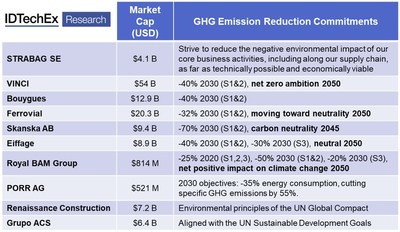Construction Industry Emission Targets Demand Electric Machines, Says IDTechEx
Construction Industry Emission Targets Demand Electric Machines, Says IDTechEx
PR Newswire
BOSTON, Aug. 19, 2022
BOSTON, Aug. 19, 2022 /PRNewswire/ -- Many major construction firms are now publishing both medium-term and long-term targets to reduce their contribution to greenhouse gas emissions, outlining their commitment to support international efforts to mitigate global climate change. Though the carbon dioxide emissions from off-road construction vehicles account for only around 1.1% of global emissions, the International Energy Agency estimates that the construction industry is responsible for approximately 20% of global emissions when the production of building materials (cement, steel, glass, etc) and infrastructure construction projects are included.
With increasing scrutiny of the environmental impact of current building practices, the electrification of mobile construction machinery offers construction companies a relatively near-term opportunity to demonstrate their environmental credentials. Scope 1 emissions refer to direct greenhouse gas emissions from sources controlled by an organization, for example, from the combustion of diesel fuel in company machines. Investment in zero-emission construction machines, replacing fossil fuel-powered excavators, loaders, and cranes, will be critical to every construction company's effort to reduce their Scope 1 emissions. The IDTechEx report, "Electric Vehicles in Construction 2022-2042," forecasts the electric construction vehicle market to grow rapidly over the next decade, with a CAGR of 37.6%.
Whilst regulatory pressure in on-road vehicle markets has driven improved fuel efficiency, reduced tailpipe emissions, and is driving a market shift towards electric vehicles, emission legislation for Non-Road Mobile Machinery (NRMM) is targeted at the emission of local air pollutants (such as nitrogen oxides, carbon monoxide, and particulates, but does not regulate greenhouse gas emissions (e.g. carbon dioxide). Introducing fuel consumption and carbon dioxide (CO2) emission standards such as those for the heavy-duty on-road market would be beneficial to the uptake of zero-emission off-road machinery, however, given the considerable time it would take to update the NRMM emission standards, other mechanisms for incentivizing zero-emission machines will need to be found.
At the highest level, pressure to reduce the greenhouse gas emissions from the construction industry is being driven by national environmental policies. The 2015 UNFCC Paris Agreement has seen the vast majority of countries commit to reducing the emission of CO2, with many having set timelines for net zero emission (Germany 2045; UK, US, and Japan 2050; China 2060). To encourage the uptake of zero-emission construction machines, governments must support the transition away from fossil fuels with economic incentives, including offering subsidies and tax breaks on electric machine purchases.
There will also be support for greener construction at a municipal level. Cities around the world are recognizing the impact of poor air quality on the health of their citizens and are making efforts to reduce air pollutant emissions. Implementing low emission zones in cities, where a daily fee must be paid to operate diesel machines within the zone, could greatly improve the financial viability of electric construction machines. Oslo, the capital city of Norway, is notably promoting green construction. In 2019 they established the first zero-emission urban construction site, and from 2030 onward, they will, along with six other major cities in Norway, ban non-zero emission machines from construction sites. Norway's strong policy has spurred the development of many heavy-duty electric construction vehicle prototypes in Europe.
Of fundamental concern for construction firms should be the health of their employees. Whilst improving worksite air quality by eliminating diesel particulate emission is a key benefit, noise reduction is also a massive positive driver for the electrification of construction machines. Electric machines are considerably quieter than combustion engines. Bobcat, for instance, suggests that the noise level of their E10e mini excavator is around half that of a similar diesel machine with an LpA (operator noise) of 74 dB(A), this is about the volume of a conversation. The construction industry is a high-risk industry for noise-related ill health, including hearing loss. Hearing protection is required on many sites. However, this can hinder communication, affecting both site safety and productivity. Noise pollution is also an inconvenience for the area around building sites, and noise restrictions in urban and suburban environments limit the operational hours in which machines can operate. Zero-emission construction machines could both vastly improve the working environment and offer the potential for extended working hours.
Though construction vehicles lack the regulatory levers around exhaust greenhouse gas emissions to force manufacturers to move toward zero-emission machines, broader commitments to climate change are already spurring countries and companies to act. Health and safety concerns like the impact of diesel particulate exhaust emissions and loud noise on construction workers health could be equally important drivers for machine electrification.
For the full picture around this developing market, IDTechEx's report "Electric Vehicles in Construction 2022-2042" investigates ongoing electrification work over the range of construction machine types, including excavators, wheel loaders, cranes, and telehandlers, highlighting technical and economic considerations of powertrain electrification. The report provides IDTechEx's independent 20-year outlook for the electric construction vehicle market, with forecasts for sales, battery demand, and market revenue, by machine type, and separate regional forecasts for Europe, China, and the US.
For more information on this report, please visit www.IDTechEx.com/EVConstruction. The Electric Vehicles in Construction report is part of IDTechEx's broader mobility research portfolio, tracking the adoption of electric vehicles, battery trends, autonomy, and demand across land, sea, and air. Find out more at www.IDTechEx.com/Research/EV.
About IDTechEx
IDTechEx guides your strategic business decisions through its Research, Subscription and Consultancy products, helping you profit from emerging technologies. For more information, contact [email protected] or visit www.IDTechEx.com.
Images download:
https://www.dropbox.com/sh/3zqrg2lfp65oaks/AABa7JDXPtC3Qe69we07hWh_a?dl=0
Social Media Links:
Twitter: https://www.twitter.com/IDTechEx
LinkedIn: https://www.linkedin.com/company/idtechex/
Facebook: https://www.facebook.com/IDTechExResearch
Photo - https://mma.prnewswire.com/media/1880996/IDTechEx_Emission_Research.jpg
Logo - https://mma.prnewswire.com/media/478371/IDTechEx_Logo.jpg
Media contact:
Natalie Moreton
Digital Marketing Manager
[email protected]
+44 (0)1223 812300
![]() View original content to download multimedia:https://www.prnewswire.com/news-releases/construction-industry-emission-targets-demand-electric-machines-says-idtechex-301608619.html
View original content to download multimedia:https://www.prnewswire.com/news-releases/construction-industry-emission-targets-demand-electric-machines-says-idtechex-301608619.html
SOURCE IDTechEx



